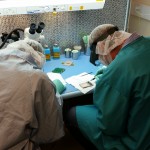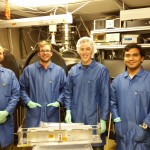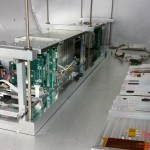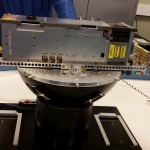Breakneck pace!
The last 2 weeks have been intense for the MinXSS project and multiple blog posts were warranted but now is the first chance I’ve had to post about all the cool things that have been going on. So two weeks ago, we had a bunch of pieces. Today, we have two integrated spacecrafts that are only missing solar arrays. I’m writing from the National Institute of Standards and Technology (NIST) / Synchortron Ultraviolet Radiation Facility (SURF) in Maryland, where we are preparing for instrument calibrations. So, here’s a rundown of what’s happened:
- Tom Woods and Andrew Jones got our secondary science instruments built up. This is a 3D printed aluminum case with neutral density and beryllium filters in it to get just the right light from the Sun to our fancy diode detectors. The diodes and processing electronics are extremely electrical static discharge sensitive, so good on Tom and Andrew for the necessary care to get those integrated in a pristine condition.
- Our CubeSat rails were anodized by a company in California that does all of the anodization for Pumpkin, one of the biggest suppliers of CubeSat components in the United States.
- A MILLION little (literally) last minute modifications to hardware as we discovered some minor, and some less minor, parts bumping into each other. This is a sure thing to happen the first time you put together a bunch of custom parts. Huge thanks to Norm Perish and Michael Klapetzky for that.
- Battery testing was finally completed, about 5 months after it was first started. Because we are going to the International Space Station, our batteries have to be very thoroughly qualified to ensure the safety of the astronauts and the station.
- We integrated the whole spacecraft! There was an entire week of 11-14 hour days to get that done.
- Gregg Allison wrote an enormous amount of code and got our flight software in great shape. He and Beth Cervelli got our ground software (unfortunately named ISIS, pretty bad timing if you follow current world events) in good shape.
- I (James Mason), along with Amir Caspi and Chris Moore, got a real time data pipeline working for science data. It displays plots of data from the 3 science instruments on MinXSS just a few seconds after the data were taken. It doesn’t even require any cables. I can be pretty much anywhere with my laptop and get the data to show up.
- We stuck the integrated spacecraft (only missing solar panels) on a mass scale and it was only 3.03 kg! We’re allowed up to 4.8 kg on NanoRacks (typical 3U CubeSats would be 4.0). Amazingly, we’re way under budget.
- AIR BEARING TEST! This was really exciting. Rick Kohnert has been building an air bearing table in his garage at home for testing out the pointing functionality of our 3-axis attitude determination and control system (ADCS) from Blue Canyon Technologies, called the XACT. The table is basically a curved cylinder that blows air to a hemisphere that rests on it, causing the hemisphere to float. On top of that, you strap the CubeSat. Then the ADCS can turn the CubeSat in a frictionless environment. So the thing is literally floating on air. Two people from Blue Canyon came out for the test, including Matt Carton, a former student from the MinXSS graduate project. See the video and pictures below.
A thousand other things have happened and so many people at LASP and CU have been involved in making it possible for us to have 2 integrated spacecrafts that are functional in time for calibration at SURF. But rather than write more, here’s a bunch of pictures!






